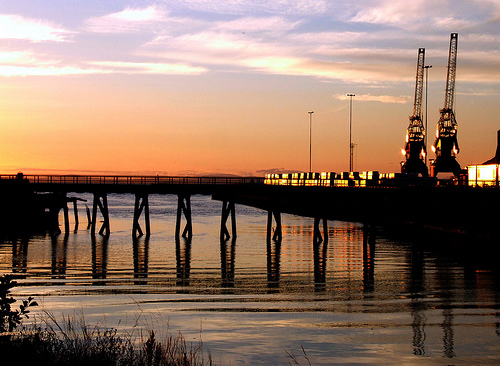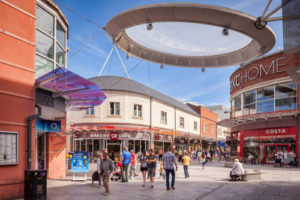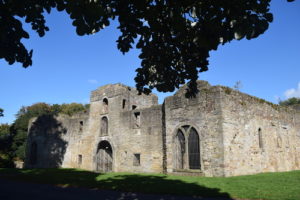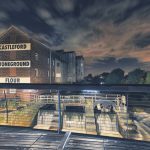
Workington The Rugby Town With A Once Famous Football Team
Workington is a port town situated on the west Cumbrian coast of north-west England. Set in the Borough of Allerdale at the mouth of the River Derwent, it’s some 32 miles southwest of the county capital, Carlisle, and about 9 miles west of the North Lakes. The town has a long industrial history, linked to both the coal mining and steel industries. At the 2011 Census, it had a population of 25,207.
Go to the Cumbria Business Directory
A Fleeting History
The towns history dates back to Roman times of AD 79, when during their occupation, the town was the site of a fort that formed part of Hadrian’s Coastal defences against the Scots.
The origin of the name Workington is thought date back to Anglo-Saxon times from; Weorc (most probably a man’s name), the suffix -ingas (sons or people of) and tūn (settlement or estate). With Weorc as the leader of the original Anglo-Saxon settlers in the area, they would have called themselves Weorcingas (Weorc’s people) and the settlement Weorcinga tun (estate of the Weorcingas).
More than a century ago, an iconic Viking sword was discovered at the town’s Northside. The sword was believed to be part of a burial ritual in an area that has subsequently proved to be rich in evidence of Viking activity.
By the 13th century, the Curwen family had established their credentials with the crown and as local nobility. Sir Gilbert (the 3rd) de Curwen (c. 1296 – 1370), received his knighthood on the battlefield at Crecy in 1346. He and his men fought alongside King Edward III of England as he attempted to seize the French throne after the death of Charles IV.
In 1379, Sir Gilbert (the 4th) received a licence to fortify the Pele tower built by his father in Workington in 1362. The improved and extended Pele tower became known as Curwen Hall. It was one of the finest houses in the region and served as the Curwen hereditary seat.
Mining To The Fore
In 1566, Queen Elizabeth I personally gave the instruction for the mining of metal ores in the area Keswick to be stepped up as England was desperately short of cannons and weaponry. The ore was smelted in the town with timber being imported from Ireland to facilitate the process. The ongoing port activity ensured that the harbour facilities were improved and expanded.
In 1568, Workington Hall served as a refuge for Mary Queen of Scots during her flight from Scotland. She sailed across the Solway Firth from Dundrennan Abbey in Scotland, landing on Workington’s shore on the 16th May 1568. She stayed there for three days and in Cockermouth for a night, before being escorted to Carlisle Castle, where she was imprisoned for a couple of months. It was the start of her 19 years in captivity, which ended with her trial and execution.
When James I ascended to the English throne in 1603, uniting the crowns of Scotland and England, he was determined to end the activities of the notorious Border Reivers (raiders). Many of the ringleaders and their families were brought here for passage to remote parts of Ireland. The Curwens’ assisted the king by imprisoning the families in a small dungeon at Workington Hall. What happened to them was never documented!
Industrial Workington
By the beginning of the 17th century, coal from Workington’s mining industry was being exported to Ireland. During the 18th and 19th centuries, more than thirty pits were in operation in the Workington area. The low phosphorous content of the local coal meant it was at Workington that Henry Bessemer set up his revolutionary process for the mass production of mild steel.
The opening of the Workington Haematite Company’s ironworks north of the town in 1856 heralded the expansion of the iron and steel industry. In 1871 the world’s first large-scale steelworks was opened in the Moss Bay area of the town. Workington was to remain at the centre of steel production in northwest England for more than the next 100 years.
The town became particularly renowned for the manufacture of steel railway tracks, which were exported all over the world. At this time, Workington also experienced major population growth, as it almost trembled from 8,413 in 1871, to 23,749 in 1891. However, paradoxically the town’s last pit, Workington Colliery, ceased coal production in 1875.
The coming of the railway in 1847 linked the town to the other industrial centres in west Cumberland. The port’s capacity expanded with the construction of the Lonsdale Dock in 1865 and further improvement works in 1917. In 1927, the dock was made deeper and wider and renamed the Prince of Wales Dock. However, by this time the docks were already in appreciable decline; while in 1870, there were 90 ships registered at Workington, by 1900 the number had decreased to only 8 or 9.
During the Second World War, an innovative electric steel furnace that produced aircraft engine steel ball bearings was moved to Workington from Norway to prevent it from falling into enemy hands.
The Modern Era
The decline of heavy industry in the town after the Second World War saw a downward drift in population. From a peak of 29,552 in 1961, the town’s population had declined to 24,295 by 2001, at a time when the populace of the rest of the country was increasing.
After almost a century of operation in the town, the Bessemer converter closed down in July 1974. The powers of the port authority were transferred from a subsidiary of British Steel to Cumbria County Council a year later. And despite having just received significant government infrastructure investment, Moss Bay Steelworks closed in 1982. However, the production of railway tracks did continue until 2006, using steel manufactured elsewhere.
The total loss of the two industries on which Workington was built, coal and steel, the town along with the rest of West Cumbria became an unemployment blackspot. Today, the situation has somewhat improved, the old iron ore workings and slag heaps have been flattened and sites re-landscaped for modern industrial estates and out-of-town shopping centres. Many of the town’s population are also employed in the nuclear industry at Sellafield, West Cumbria’s foremost employer.
In 2006, Washington Square, a £50 million mixed-use, 275,000 sq ft, shopping complex, was opened to replace the run down 1960’s St John’s Arcade. The following year, it was named as the ‘best commercial project’ in North West England by the Royal Institution of Chartered Surveyors.

The pedestrianised Town Centre, Workington
Getting there!
Workington may be a bit off the beaten track but it’s still pretty accessible. here are some suggestions…
By Road
Take the M6 motorway and head to Carlisle, then travelling south-westerly, take the A595 all the way through.
By Train
If you’re travelling by train, then the town’s railway station is on the Cumbrian Coast Line. The train service runs between Carlisle in the north and Barrow in the south and runs approximately every hour from Carlisle throughout the day, with a journey time of 45 – 50 minute.
By Bus
Local bus services connect Workington to Whitehaven, Cockermouth, Maryport and Carlisle, and are operated by Stagecoach North West.
By Air
For our overseas readers, the nearest international airports are Manchester and Newcastle. A local domestic airport is due to open on the outskirts of Carlisle in 2019, serving Belfast, Dublin and London (Southend).
Places to see!
Helena Thompson Museum
The Helena Thompson Museum is a Grade-2 listed Georgian house, which is both a museum and a community centre. The museum is an invaluable resource that provides a balanced perspective on the history of Workington with exhibits covering the industry, culture and social life of the area. Its free entry and opens: Monday-Friday 10.00 – 16.30, Saturday by appointment only, Sunday 13.30 – 16.30.
Workington Hall
Workington Hall (aka Curwen Hall), is a ruined building on the north-east outskirts of the town. It’s a 14th century, Grade I listed building. Built by the Curwen family, it has strong connections to the monarchy having once housed Mary Queen of Scots.

Curwen Hall Image: John Fielder/Shutterstock.com
Things to do!
Cycling
The town is a starting point for the national Sea to Sea or C2C cycle route the shortest one is Workington – Sunderland: 125 miles, 202 kilometres so not for the faint-hearted. Still, Workington also has its own network of traffic-free cycle routes.
Fishing
Workington has both excellent sea and freshwater fishing. You can obtain a one-day license to fish on the River Derwent from the Workington Angling Association. The river is well known for its stock of salmon, sea trout and brown trout. There are plenty of locations where you can see fish from the shore with flounders, dabs, whiting, cod, coalfish and dogfish likely on the menu afterwards.
Watch Sport
If you’re a sports fan, then Workington has a surprisingly good selection to watch. It has long been a Rugby League stronghold and the town had one of the countries finest teams in the early 1950s. Anyway, we will go against then trend slightly and start with Football.
Workington Reds
The town has a semi-professional football team, Workington A.F.C. always referred to locally as ‘Workington Reds” who play at Borough Park. They were members of the Football league from the 1951-2 season right through to 1976-77 when they failed to get re-elected to the then 4th Division.
They did ok during this spell and were managed by Liverpool legend Bill Shankly in the 1950s. They were quite successful in the 1960s too, nearly reaching Division Two of the Football League in 1965-6 and of course they are known in footballing circles as the team who led 1-0 against the Busby Babes in the 1958 FA cup. We can attest from experience that even today a trip to Borough Park for a game is a good day out, but wrap up if you are not used to the cold!
Workington Town R.L.F.C.
Workington Town or Town to the locals are a Rugby League team with a fair bit of history, having been around since 1945 and up until the end of the 1960s were a force to be reckoned with. They were Rugby League Champions in 1951 and also lifted the Challenge Cup a year later. Five figure crowds were the norm during much of this time period but sadly their geographical isolation and the increasing importance of sponsor money has led to a decline. Still, if you love the game then get down to Derwent Park and cheer them on.
If rugby union is more your game then the, even more, historied Workington Zebras should fit the bill. They have been around since 1877 and play at the Ellis Sports Ground. They are more grassroots than championship but the standard of play is still pretty good and they have picked up a few trophies in their time including 12 Cumbria Cups!
Speedway
Workington Comets are the town’s professional speedway team, who compete in the 2nd tier of British Speedway. In 2018 they won the Speedway Great Britain (SBG) Championship for the first time in their history. They share the Derwent Park stadium with Workington Town.
Where to stay?
A rough guide to costs for the most readily available types of accommodation in and around the town are:
Guesthouse/B & B/Travel Lodge: £40 – £60
Standard Hotel: £60 – £100
3 or 4 Star Hotel: £100 – £130
Why Not Try Our Workington Quiz?


